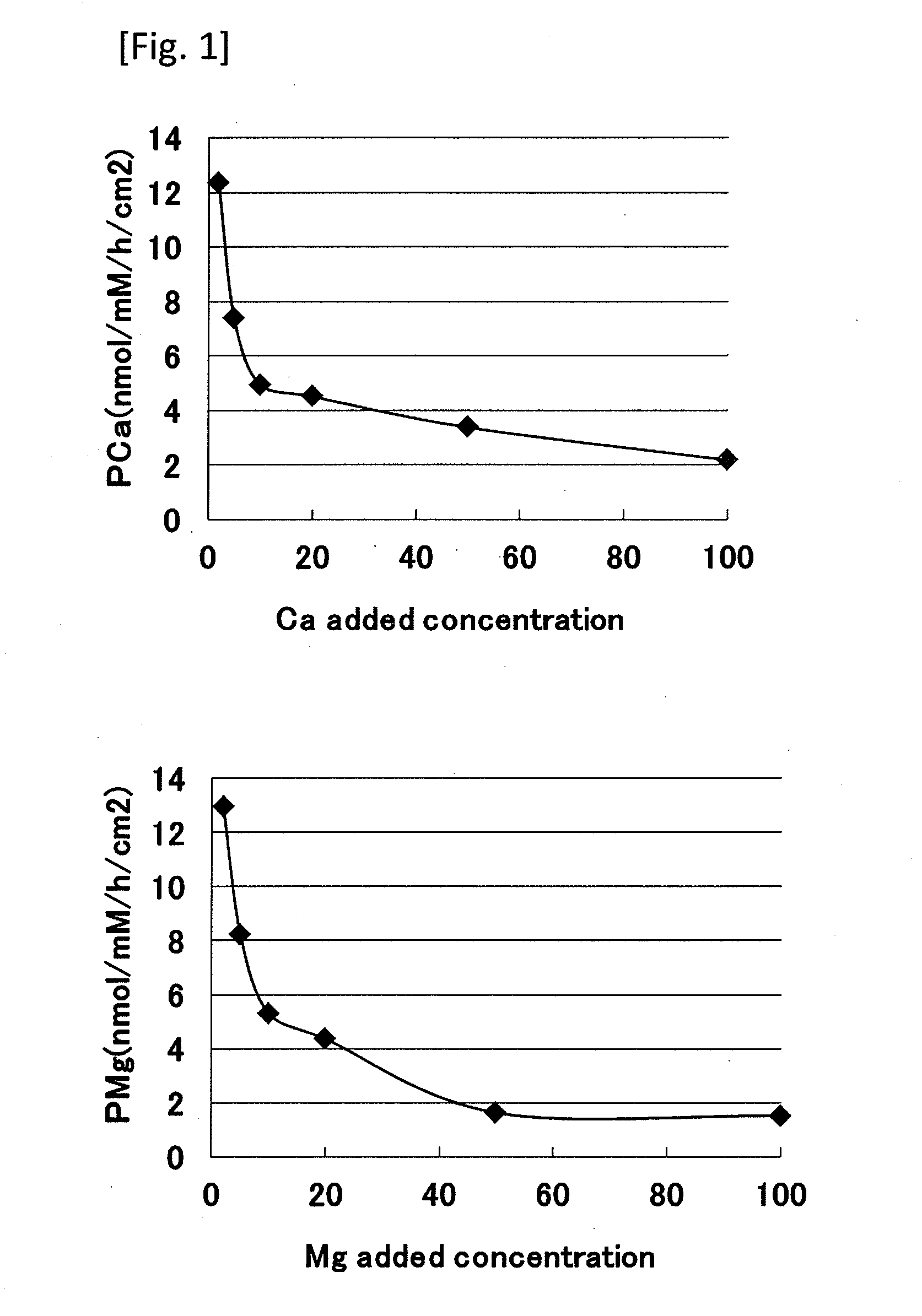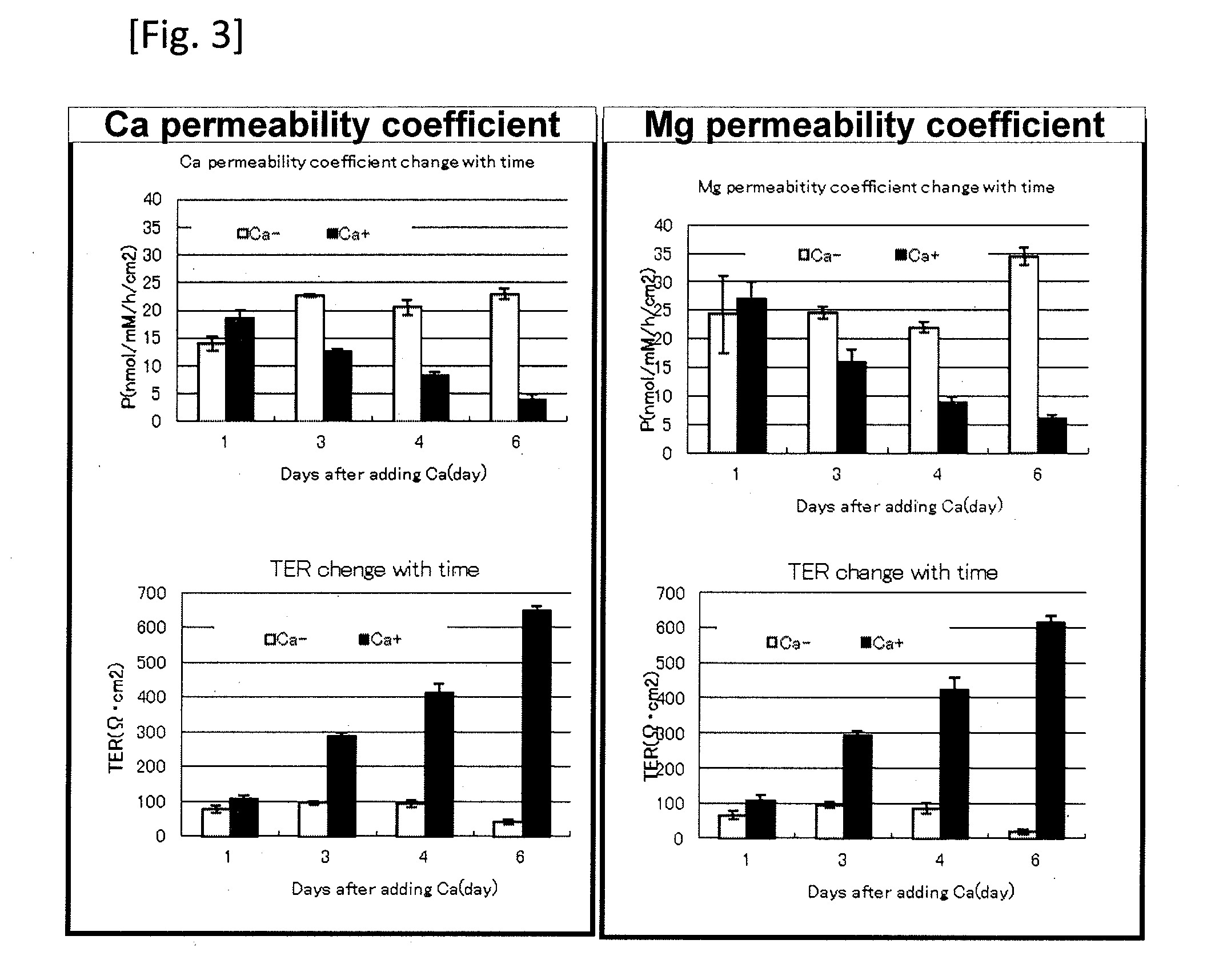Method of enhancing skin barrier function
a skin barrier and function technology, applied in the field of evaluating skin barrier function, can solve the problems of increasing the amount, skin barrier dysfunction, and liable to be recognized the expression of the above-mentioned skin barrier dysfunction, and achieve enhanced skin barrier function, and excellent ability
- Summary
- Abstract
- Description
- Claims
- Application Information
AI Technical Summary
Benefits of technology
Problems solved by technology
Method used
Image
Examples
example 1
[0048]An ion permeability test using normal human epidermal cells was performed based on a method of evaluating skin barrier function of the present invention.
[0049]1) Cell Inoculation and Ion Permeability Experiment
[0050]Frozen normal human epidermal keratinocytes (NHEK) (manufactured by Kurabo Industries Ltd.) were thawed and cultured in a 0.15 mM Ca-containing culture medium (Humedia-KG2; manufactured by Kurabo Industries Ltd.) at 37° C. in 50% carbon dioxide atmosphere. A Transwell (registered trademark) manufactured by Corning Incorporated (diameter 12 mm, polyethylene terephthalate, 0.4 μm pore) was placed on a Millicell (registered trademark) tissue culture plate (manufactured by Millipore), and the above-mentioned culture medium was added in amounts of 1.5 ml to the lower layer and 0.5 ml to the upper layer. Then, the normal human epidermal keratinocytes (NHEK) were inoculated at 1×105 / cm2 and cultured for additional 72 hours. After the cells were confirmed to be confluent, ...
example 2
[0065]In the same way as in Example 1, calcium was selected as a metal ion to be added to compare calcium permeability coefficients and magnesium permeability coefficients in a low-calcium medium cultured cells (shown as Ca− in FIG. 3) (0.15 mM) and in a high-calcium medium cultured cells (shown as Ca+ in FIG. 3) (1.45 mM). That is, frozen normal human epidermal keratinocytes (NHEK) (manufactured by Kurabo Industries Ltd.) were thawed and cultured in a 0.15 mM Ca-containing culture medium (Humedia-KG2; manufactured by Kurabo Industries Ltd.) at 37° C. in 50% carbon dioxide atmosphere. A Transwell (registered trademark) manufactured by Corning Incorporated (diameter 12 mm, polyethylene terephthalate, 0.4 μm pore) was placed on a Millicell (registered trademark) tissue culture plate (manufactured by Millipore), and the above-mentioned culture medium was added in amounts of 1.5 ml to the lower layer and 0.5 ml to the upper layer. Then, the normal human epidermal keratinocytes (NHEK) we...
example 3
[0066]TERs and metal ion permeability coefficients in the case where claudin-1, one of tight junction proteins serving as adhesion factors for epidermal cells, was suppressed with siRNA were measured in accordance with the method of Example 1. That is, frozen normal human epidermal keratinocytes (NHEK) (manufactured by Kurabo Industries Ltd.) were thawed and cultured in a 0.15 mM Ca-containing culture medium (Humedia-KG2; manufactured by Kurabo Industries Ltd.) at 37° C. in 50% carbon dioxide atmosphere. Thereafter, siRNA was transfected into the cultured cells. A Transwell (registered trademark) manufactured by Corning Incorporated (diameter 12 mm, polyethylene terephthalate, 0.4 μm pore) was placed on a Millicell (registered trademark) tissue culture plate (manufactured by Millipore), and the above-mentioned culture medium was added in amounts of 1.5 ml to the lower layer and 0.5 ml to the upper layer. Then, the human epidermal keratinocytes transfected with siRNA were inoculated ...
PUM
| Property | Measurement | Unit |
|---|---|---|
| culture time | aaaaa | aaaaa |
| diameter | aaaaa | aaaaa |
| volume | aaaaa | aaaaa |
Abstract
Description
Claims
Application Information
 Login to View More
Login to View More - R&D
- Intellectual Property
- Life Sciences
- Materials
- Tech Scout
- Unparalleled Data Quality
- Higher Quality Content
- 60% Fewer Hallucinations
Browse by: Latest US Patents, China's latest patents, Technical Efficacy Thesaurus, Application Domain, Technology Topic, Popular Technical Reports.
© 2025 PatSnap. All rights reserved.Legal|Privacy policy|Modern Slavery Act Transparency Statement|Sitemap|About US| Contact US: help@patsnap.com



